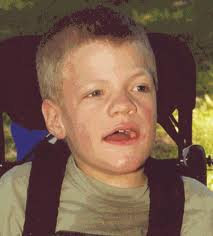What is Sanfilippo Syndrome?
Page Contents
- 1 What is Sanfilippo Syndrome?
- 2 Sanfilippo Syndrome Epidemiology
- 3 Sanfilippo Syndrome Types
- 4 Sanfilippo Syndrome Causes
- 5 Sanfilippo Syndrome Symptoms
- 6 Sanfilippo Syndrome Diagnosis
- 7 Sanfilippo Syndrome Treatment
- 8 Sanfilippo Syndrome Complications
- 9 Sanfilippo Syndrome Prognosis
- 10 Sanfilippo Syndrome Life Expectancy
- 11 Sanfilippo Syndrome Pictures
Sanfilippo Syndrome is a type of rare form of lysosomal storage disease that is inherited in an autosomal recessive pattern. It occurs due to a deficiency in one of the enzymes required to break down glycosaminoglycan heparan sulfate that can be found on the cell surface glycoproteins and also in extra-cellular matrix.
The condition has been named after Sylvester Sanfilippo, the pediatrician who described this disease for the first time. The condition is also known as Mucopolysaccharidosis III or MPS-III.
Sanfilippo Syndrome Epidemiology
The incidence of this condition might vary geographically, with only 1 per 50000 people in the Netherlands, 1 per 66000 people in Australia and 1 per 280000 cases in Northern Ireland.
Sanfilippo Syndrome Types
There are four main types of this syndrome, each of which is caused by a specifically affected enzyme:
Type A
This is the most critical form of the condition. The enzyme known as heparan N-sulfatase is either missing or present in an altered form in patients having this form.
Type B
This syndrome occurs when an individual is either missing or does not produce enough amounts of alpha-N-acetylglucosaminidase.
Type C
This type occurs when the patient is missing or does not produce sufficient amounts of acetyl-CoAlpha-glucosaminide acetyltransferase.
Type D
This form develops when an individual is missing or does not produce enough amounts of N-acetylglucosamine 6-sulfatase.
Sanfilippo Syndrome Causes
Sanfilippo Syndrome develops due to a mutation in one of the genes that control the production of various enzymes that assist in breaking down the heparan sulfate sugar chain. Heparan sulfate can be classified as a type of mucopolysaccharides or glycosaminoglycan, a substance that has among other constituents long carbohydrate chains that are essential components of different tissues within the body.
Small units known as lysosomes can be found in various bodily cells except red blood cells. It is here that various materials are broken down. Lysosomes play an important role in managing and breaking down different substances with the assistance of the enzymes. Enzymes are protein substances that contribute to the various biochemical processes without themselves getting broken down. In the patients of Sanfilippo syndrome, a deficiency can be seen in one of the four enzymes:
- Heparan N-sulfatase
- Alpha-N-acetylglucosaminidase
- Acetyl-CoAlpha-glucosaminide acetyltransferase
- N-acetylglucosamine 6-sulfatase
This hinders the breakdown of mucopolysaccharides, which get accumulated in the cells. This can, in turn, cause progressive damage of the different tissues and bodily organs.
Sanfilippo Syndrome Symptoms
The clinical symptoms presented by patients of all the four variants of Sanfilippo syndrome are more or less indistinguishable from each other, even though different genetic mutations are responsible for each disease. The disease first manifests in young infants and children. They are born in good health and have normal growth between the ages of 2 to 6 years.
Although patients appear apparently normal, some mild facial dysmorphisms might later become noticeable. Other features, such as hirsuteness, stiff joints and coarse hair that are typical of the other forms of mucopolysaccharidoses are generally not present until later in the disease. This is followed by a symptom-free interval following which a slower rate of development accompanied by behavioral problems can be seen. This is again followed by a progressive intellectual decline which results in severe dementia as well as progressive motor disease. Affected children frequently show slow and incomplete acquisition of speech. They can also have difficulties in chewing and can easily choke on food.
The condition then progresses with sufferers showing more and more behavioral disturbances such as:
- Hyperactivity
- Temper tantrums
- Aggressive behavior
- Destructiveness
- Pica
- Sleep disturbances
Since the affected children display normal muscular strength and mobility, these behavioral disturbances are not easy to manage. Difficulties in sleep that are experienced by patients are especially difficult to manage by the care providers. Suffering children become progressively immobile and unresponsive during the last phase of the condition, often requiring wheelchairs. Seizures and swallowing difficulties are also seen in the advanced stages.
Although the main features associated with this condition are generally neurological, patients may also exhibit any or all of the following symptoms:
- Full lips
- Epilepsy
- Diarrhea
- Stiff joints
- Gallstones
- Pneumonia
- Carious teeth
- Heavy eyebrows
- Umbilical hernias
- Tongue protrusion
- Enlarged spleen and liver
- Large head circumference
- Gastrointestinal problems
- Large adenoids and tonsils
- Underdeveloped hip joints
- Upper respiratory tract infections
- Large ribcage along with protruding abdomen
- Spinal abnormalities such as kyphosis and scoliosis
- Normal height during the initial years but below average final height
- Ear infections; hearing can get impaired due to recurrent ear infections, along with building up of fluids behind the eardrums
Children with this syndrome often show an increased pain tolerance. Due to this, toothaches and ear infections might become difficult to notice as they do not cause as much difficulties as they would to the other children. However, it is essential to detect symptoms like ear infections or bumps and bruises in children having Sanfilippo syndrome which might sometimes be overlooked.
Sanfilippo Syndrome Diagnosis
While conducting the diagnosis of this syndrome, a doctor is likely to first conduct a thorough evaluation of a patient’s genetic history and carry out an overall physical exam. The signs that show swelling of liver and the spleen may get detected in the physical exam. Eye exams demonstrate clear corneas which are unlike the cloudy ones seen in individuals having Hurler syndrome. Neurological testing can reveal symptoms of seizures along with intellectual disabilities. Urine tests can help in detecting large amounts of mucopolysaccharides in a patient’s urine. This is followed by blood tests which can help in detecting the type of enzyme that is deficient. Other diagnostic tests that are carried out to detect this syndrome include:
- Bone X-rays
- Echocardiogram
- Slit lamp eye exam
- Skin fibroblast culture
The diagnosis can be made on the basis of a DNA testing. Genetic counseling should be offered to the family of sufferers during the time of diagnosis. Prenatal diagnosis, carrier diagnosis and embryonic diagnosis can be made possible if the genetic mutation within the family has already been identified.
Sanfilippo Syndrome Treatment
At present, there are no treatment options for Sanfilippo syndrome. Treatment is primarily meant to provide support to patients by preventing medical complications and easing the challenges posed by everyday tasks. This can help to improve the overall quality of the life of sufferers and bring comfort to their family. Research is being conducted on the effectiveness of genistein, a soya protein supplement. Contradictory results have been found on this research, and this protein does not appear to influence the development of the brain.
Antibiotics
Pneumonia, ear infections and upper respiratory problems are managed with antibiotics. It might also become necessary to insert plastic tubes or grommets through the eardrums in order to drain fluid. Epilepsy is quite common and managed by using anti-epileptic medications.
Lactose-free diet
Many children suffer from periodic episodes of diarrhea that might be challenging to manage. A lactose-free diet is recommended for such patients. The food should be chopped finely if a child is experiencing problems associated with chewing and choking. If there are still problems with feeding, or if the child still refuses to eat, the usage of a PEG might become necessary. Percutaneous endoscopic gastrostomy (PEG) is a surgical procedure that helps to create a direct link through abdominal wall and then into the stomach. A dietician should be consulted in these circumstances from a very early stage.
Melatonin
Behavioral abnormalities such as disturbed sleep patterns, hyperactivity, screaming and/or destructiveness can be very difficult to manage with medications. Children having this syndrome do not normally find it challenging to sleep. However, their sleeping patterns can be extremely irregular and medications that are used to aid in sleeping may not be that effective. The sleep disturbances can become worse with progressing age. The naturally-occurring hormone called Melatonin has been proven to be effective in curing sleep disturbances in recent years when it is combined with proper sleeping habits.
Hematopoietic stem cell transplant
It is a treatment procedure that can be used to replace the missing enzymes in some enzyme deficiency diseases. However, long term observation of children having this syndrome who have been through such transplantations reveal that the procedure has got no effect on buildup of heparan sulfate within the brain. Due to this reason, this procedure is no longer carried out for patients of Sanfilippo syndrome.
Bone marrow replacement therapy
The condition can be treated by using bone marrow replacement therapy during the earlier stages. Although it is possible to administer the missing enzyme intravenously, it cannot pass through the blood-brain barrier and hence cannot cure the neurological problems associated with the disease. Other treatment procedures include gene therapy and chemical modification of the deficient enzymes which allows them to penetrate blood-brain barrier and stabilization of the abnormal but active enzymes to prevent their degradation.
Children with this syndrome can have a blood-clotting problem that is caused by large amounts of heparan sulfate in the blood. Hence, they should be examined specifically for this reason and treated before conducting any other operation.
Sanfilippo Syndrome Complications
The following complications might develop in patients with this syndrome:
- Seizures
- Blindness
- Intellectual impairment
- Inability to take care of the self
- Nerve damage that progressively worsens over time
Sanfilippo Syndrome Prognosis
The condition is known to cause significant neurological symptoms along with severe intellectual disability. The IQ of patients might be below 50. The majority of sufferers of this syndrome barely live into the teenage years. Some individuals might live longer, whereas others with more severe forms might die earlier. The symptoms appear most critical in people having Sanfilippo syndrome Type A.
Sanfilippo Syndrome Life Expectancy
The life expectancy of a child with this syndrome is anywhere between 8 to 25 years.
Sanfilippo Syndrome Pictures
The images below show the appearance of patients of this syndrome.
Picture 1 – Sanfilippo Syndrome
Picture 2 – Sanfilippo Syndrome Image
References:
http://en.wikipedia.org/wiki/Sanfilippo_syndrome
http://www.nlm.nih.gov/medlineplus/ency/article/001210.htm
http://www.socialstyrelsen.se/rarediseases/sanfilipposyndrome
http://www.isabelfoundation.org/About%20Sanfilippo.html



we have a son the has mps lll b, when he was diagnosed, we as a family decided not to give him medicines unless he just had to have them because of all the side effects. we believe this is why he has made it to 18 and just this last yr are showing signs of regressing. we also believed as a child growing up that let him be a child not to coddle him but to let him play be a kid, . we feel this has made him to be stronger. we also gave him probiotics as well as activia yougurt, this took the dishrea away.